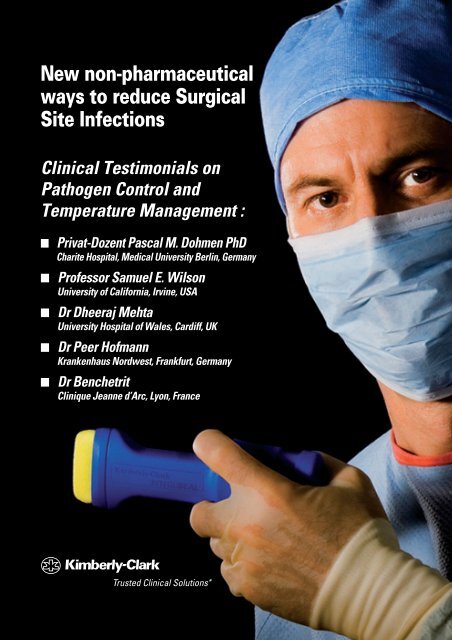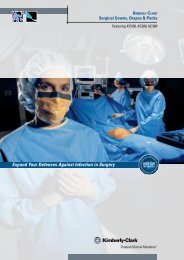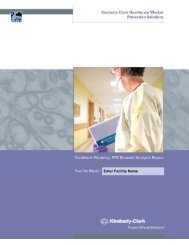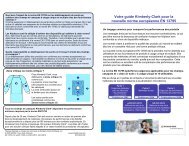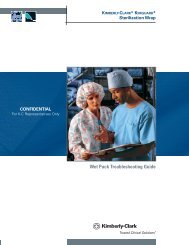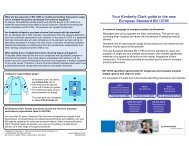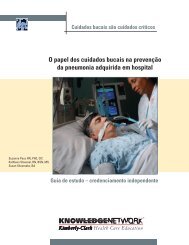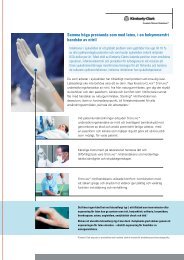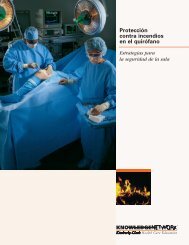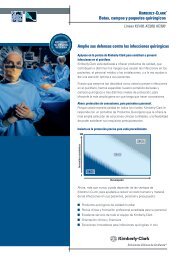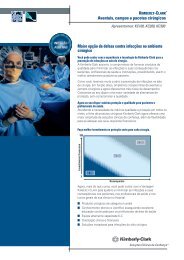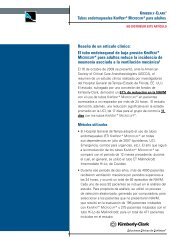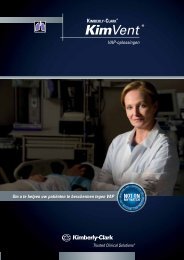Impose?:Mise en page 1 - Digestive Health
Impose?:Mise en page 1 - Digestive Health
Impose?:Mise en page 1 - Digestive Health
Create successful ePaper yourself
Turn your PDF publications into a flip-book with our unique Google optimized e-Paper software.
New non-pharmaceutical<br />
ways to reduce Surgical<br />
Site Infections<br />
Clinical Testimonials on<br />
Pathog<strong>en</strong> Control and<br />
Temperature Managem<strong>en</strong>t :<br />
■ Privat-Doz<strong>en</strong>t Pascal M. Dohm<strong>en</strong> PhD<br />
Charite Hospital, Medical University Berlin, Germany<br />
■ Professor Samuel E. Wilson<br />
University of California, Irvine, USA<br />
■ Dr Dheeraj Mehta<br />
University Hospital of Wales, Cardiff, UK<br />
■ Dr Peer Hofmann<br />
Krank<strong>en</strong>haus Nordwest, Frankfurt, Germany<br />
■ Dr B<strong>en</strong>chetrit<br />
Clinique Jeanne d’Arc, Lyon, France
KIMBERLY-CLARK*<br />
Testimonial
KIMBERLY-CLARK*<br />
Testimonial<br />
Clinician testimonial<br />
Based on an interview with<br />
Professor Samuel E Wilson, from the University of<br />
California, Irvine, USA<br />
Interview conducted by Neil McK<strong>en</strong>drick PhD,<br />
as part of the Kimberly-Clark symposium<br />
New non-pharmaceutical ways to reduce surgical<br />
site infections.<br />
Locking down pathog<strong>en</strong>s to lock out contamination<br />
Professor Samuel E Wilson, from the University of California, Irvine, USA, is the<br />
lead investigator of the first clinical trial with InteguSeal in surgical pati<strong>en</strong>ts.<br />
“Our clinical trial design aimed to focus on a common operation, where<br />
infection is not expected but would compromise the effectiv<strong>en</strong>ess of the<br />
procedure should it occur. We selected inguinal hernia repair for the trial for<br />
several reasons. It is a very common procedure and one does not expect<br />
postoperative infection because it is a clean surgical wound. But if an<br />
infection does occur, it undermines the whole purpose of the operation: if a<br />
prosthesis has be<strong>en</strong> implanted, it will have to be removed and secondary<br />
repair of the hernia will be necessary. Furthermore, it can be difficult to apply<br />
standard adhesive drapes in the area of the inguinal skin fold.<br />
I should point out that our goal in the trial was not to compare infection rates<br />
betwe<strong>en</strong> InteguSeal and a control, because the numbers would be low –<br />
perhaps about one in a hundred procedures. Our aim was to show whether<br />
InteguSeal reduced the recovery of bacteria from the wound: did InteguSeal <br />
secure the skin flora so that they did not <strong>en</strong>ter the operative field?<br />
Our trial involved 177 pati<strong>en</strong>ts at five sites in the US. Each pati<strong>en</strong>t underw<strong>en</strong>t<br />
standard skin preparation with Betadine scrub, after which half were<br />
randomized to receive InteguSeal . We recognized that if we used wound<br />
infection as our <strong>en</strong>dpoint we would require several thousand pati<strong>en</strong>ts to<br />
show a significant differ<strong>en</strong>ce betwe<strong>en</strong> the groups. However, we believed<br />
that if we could show a significant reduction in wound contamination with<br />
InteguSeal , surgeons could accept this as a great advantage for ultimately<br />
prev<strong>en</strong>ting wound infection. To do this we used a specially developed<br />
procedure to obtain cultures from the subcutaneous tissue immediately after<br />
making the incision, and immediately before closing the fascia and skin: the<br />
average duration of the procedure was about 1 hour.”
KIMBERLY-CLARK*<br />
Testimonial<br />
The results of this study showed that wound contamination was pres<strong>en</strong>t in<br />
53.0% of pati<strong>en</strong>ts in whom InteguSeal was used, compared with 68.7% in the<br />
control group, that is a 16% reduction (P=0.04). This b<strong>en</strong>efit of InteguSeal was<br />
se<strong>en</strong> at all sites, and was indep<strong>en</strong>d<strong>en</strong>t of the use of prophylactic antibiotics<br />
or removal of body hair by clipping.<br />
“We have since used InteguSeal in our routine clinical practice. The nurse<br />
applies InteguSeal as part of the standard skin preparation, a practice which<br />
has worked very well. InteguSeal is very easy to put on the skin, and it<br />
adheres very tightly. I think InteguSeal has great application, also for those<br />
areas where it is difficult to apply antiseptic-impregnated drapes. It is particularly<br />
useful in areas where there are skin folds, and for most standard operative<br />
procedures. The only thing to note is that the skin has to be dry before<br />
application.<br />
One unexpected question that came up during our study was: how does<br />
InteguSeal come off the skin? It exfoliates naturally from the pati<strong>en</strong>t’s skin :<br />
we found that in most pati<strong>en</strong>ts InteguSeal was quickly removed once they<br />
started taking showers or baths (on average, about 72 hours after the procedure).<br />
After 1 week, there was very little evid<strong>en</strong>ce of residual InteguSeal remaining<br />
on the skin.<br />
Postoperative infections are exp<strong>en</strong>sive complications because the pati<strong>en</strong>t’s<br />
hospitalization is prolonged and ext<strong>en</strong>sive treatm<strong>en</strong>t may be needed. The<br />
prev<strong>en</strong>tion of one wound infection will go a long way towards countering any<br />
costs incurred in using InteguSeal . In g<strong>en</strong>eral, hospital administrators want<br />
to keep their costs down: they want surgeons to get their pati<strong>en</strong>ts home as<br />
soon as possible, and avoiding complications is one way to do that.<br />
Looking into the future, I think that InteguSeal is likely to become a routine<br />
part of operative procedures. Non-antimicrobial methods of prev<strong>en</strong>ting<br />
infection are likely to become increasingly important; although antibiotics<br />
are irreplaceable for contaminated procedures such as gastrointestinal<br />
surgery their role in clean procedures remains somewhat controversial.<br />
I believe that there will be a r<strong>en</strong>ewed emphasis on operating room discipline,<br />
with every effort being made to prev<strong>en</strong>t wound contamination with skin<br />
bacteria. This is where I believe InteguSeal has the best role.”
KIMBERLY-CLARK*<br />
Testimonial
KIMBERLY-CLARK*<br />
Testimonial<br />
Clinician testimonial<br />
Based on an interview by Pascal M. Dohm<strong>en</strong> MD PhD<br />
(Charité Hospital, Medical University Berlin, Berlin, Germany)<br />
Interview conducted by Neil McK<strong>en</strong>drick PhD,<br />
22 June 2007, at the SAS Radisson Hotel in Reykjavík, Iceland<br />
as part of the Kimberly-Clark symposium<br />
New non-pharmaceutical ways to reduce surgical site infections.<br />
InteguSeal ® : a promising developm<strong>en</strong>t for surgical site infection<br />
prophylaxis<br />
As a cardiac surgeon in the Departm<strong>en</strong>t of Cardiovascular Surgery at the<br />
Charité University Hospital in Berlin, I perform a wide range of cardiac surgery<br />
procedures in adult pati<strong>en</strong>ts, including cardiac bypass surgery, aortic surgery,<br />
valve surgery, and Ross procedures (aortic valve replacem<strong>en</strong>t with the autologous<br />
pulmonary valve). With four of our six surgeons available at any one time, plus the<br />
head of the departm<strong>en</strong>t, Professor Konertz, and nine resid<strong>en</strong>t trainee staff, we carry<br />
out approximately 1500 operations every year. In addition to this, as a large<br />
cardiovascular surgery university departm<strong>en</strong>t, we also have substantial teaching<br />
and research commitm<strong>en</strong>ts.<br />
I also lead the research departm<strong>en</strong>t of the Tissue Engineering Section and<br />
our main area of research interest is the developm<strong>en</strong>t of new heart valves<br />
using tissue <strong>en</strong>gineering 1–3 . Pati<strong>en</strong>ts undergoing cardiothoracic surgery are<br />
at substantial risk of developing SSI, 4 so as a cardiac surgeon, I am also<br />
interested in the prev<strong>en</strong>tion of SSI.<br />
SSI can be devastating in cardiac surgery pati<strong>en</strong>ts<br />
We already have a quality managem<strong>en</strong>t programme in our departm<strong>en</strong>t and<br />
soon all hospitals in Germany will be required to publish their results for<br />
surgical outcomes from the previous year. The effect of this will be to g<strong>en</strong>erate<br />
competition betwe<strong>en</strong> hospitals because pati<strong>en</strong>ts will compare results across<br />
c<strong>en</strong>tres before choosing the one at which they prefer to be treated. So high<br />
quality outcomes, while clearly important for pati<strong>en</strong>ts, are also important for<br />
clinical c<strong>en</strong>tres. A major issue in terms of treatm<strong>en</strong>t outcomes is the incid<strong>en</strong>ce<br />
of SSIs, which remains one of the main complications of cardiac surgery.<br />
The preval<strong>en</strong>ce of SSIs among pati<strong>en</strong>ts undergoing cardiothoracic surgery<br />
has be<strong>en</strong> reported to range from 1.3% to 12.3%, while sternal SSI may occur<br />
in up to 20% of pati<strong>en</strong>ts 5,6 . SSIs are associated with increased morbidity in<br />
cardiac surgery pati<strong>en</strong>ts; mediastinitis, for example, has devastating consequ<strong>en</strong>ces.<br />
In addition, sternal wound complications oft<strong>en</strong> have a late onset and are<br />
detected after pati<strong>en</strong>ts are discharged from the hospital. Retrospective data<br />
estimate that SSIs contribute 1.47-19.1 billion Euros to the economic costs of<br />
surgical procedures in Europe 7 .
KIMBERLY-CLARK*<br />
Testimonial<br />
While the quality of outcomes is excell<strong>en</strong>t across hospitals in Germany, with<br />
g<strong>en</strong>erally low rates of adverse surgical outcomes, outcome rates are a key<br />
factor considered by pati<strong>en</strong>ts wh<strong>en</strong> selecting a hospital. More high-risk<br />
pati<strong>en</strong>ts are normally treated at the university or other public hospitals, and<br />
the more high-risk pati<strong>en</strong>ts treated at a c<strong>en</strong>tre, the higher the rate of adverse<br />
treatm<strong>en</strong>t outcomes for that c<strong>en</strong>tre is likely to be. This also emphasizes the<br />
importance of reliable detection and accurate reporting of SSI rates.<br />
An ageing population: more elderly pati<strong>en</strong>ts<br />
In Germany, as in many European countries, populations are becoming older.<br />
Increasing numbers of very elderly pati<strong>en</strong>ts are being referred for valve and<br />
other cardiac surgery. Although valve surgery achieves good long-term<br />
survival and an improved function in elderly pati<strong>en</strong>ts, many have a wide<br />
variety of chronic, debilitating, or immunocompromising concomitant, oft<strong>en</strong><br />
subclinical, diseases that contribute to increased risk of SSI 8 and postoperative<br />
morbidity and mortality.<br />
Prev<strong>en</strong>tion is better than treatm<strong>en</strong>t<br />
Effective antibiotics are an ess<strong>en</strong>tial weapon with which to fight SSI. But we<br />
know from our microbiologist colleagues that there is increasing antibacterial<br />
resistance, particularly among common nosocomial pathog<strong>en</strong>s. Both<br />
staphylococci and <strong>en</strong>terococci have developed alarming rates of resistance<br />
to multiple antibiotics 9 , but the resistance to antibiotics of other Gram-positive<br />
organisms, including micrococci, diphtheroids and Propionibacterium acnes,<br />
and Gram-negative bacilli is also a major concern 10 . What we need are better<br />
ways of prev<strong>en</strong>ting SSI without medication and without antibiotics, and this is<br />
where pharmaceutical companies and medical device companies can help.<br />
Clinical experi<strong>en</strong>ce is growing<br />
After InteguSeal ® was introduced in our hospital approximately 18 months<br />
ago, we conducted a pilot study in 40 surgical pati<strong>en</strong>ts. Of these pati<strong>en</strong>ts,<br />
there was one pati<strong>en</strong>t with a major risk factor who developed a SSI. With<br />
treatm<strong>en</strong>t, this pati<strong>en</strong>t recovered very quickly from the infection and made<br />
good subsequ<strong>en</strong>t progress. There were several other pati<strong>en</strong>ts with major<br />
risk factors in the study who did not develop SSI, which confirmed my belief<br />
that this was a useful adjunct to curr<strong>en</strong>t practice for minimising SSI. Since<br />
the pilot study, I have used it on all my pati<strong>en</strong>ts, while others in our surgical<br />
team use it for bypass surgery and particularly for procedures such as a bilateral<br />
internal mammary artery grafting which increases the risk of sternal SSI,<br />
especially with diabetic pati<strong>en</strong>ts. After more than 100 cases in which InteguSeal ®<br />
has be<strong>en</strong> used, there has be<strong>en</strong> only one case of SSI (the pati<strong>en</strong>t in the pilot study).<br />
I use InteguSeal ® only on the area for thoracic incision and not on the legs<br />
or on the arm because, although we also harvest major vessels from the<br />
limbs, the rate of postoperative infections at these sites is very low in our
KIMBERLY-CLARK*<br />
Testimonial<br />
institution. Before applying InteguSeal ® , I think it is important to first disinfect<br />
the pati<strong>en</strong>t with iodine solution and let the preparative solution dry, which<br />
takes about three to five minutes. We th<strong>en</strong> leave InteguSeal ® to dry for the<br />
recomm<strong>en</strong>ded time before we put the drapes in place.<br />
Using the InteguSeal ® 100, we treat across the chest from nipple to nipple<br />
and th<strong>en</strong> as far down the abdom<strong>en</strong> as possible. I also apply InteguSeal ®<br />
around the area where the drainage tubes are positioned. InteguSeal ® is<br />
easy to use, although occasionally it is difficult to see wh<strong>en</strong> dried on skin.<br />
This is likely to change as versions of the product are developed with the<br />
addition of colouring to allow it to be se<strong>en</strong> more easily after application.<br />
Efficacy not cost is the priority for SSI reduction<br />
As a doctor, it is the health and well-being of my pati<strong>en</strong>ts that are my priorities<br />
and it is far more important to me to reduce the risks of co-morbidity, particularly<br />
for higher risk pati<strong>en</strong>ts, than to achieve the reductions in the cost of healthcare.<br />
Being realistic, however, I accept that financial considerations and budgets<br />
are part of managing healthcare today and most medical departm<strong>en</strong>ts’ budgets<br />
are limited. In many cases the decision to acquire new technology needs to<br />
be based on evid<strong>en</strong>ce of cost and b<strong>en</strong>efit. This is not least because there are<br />
other new healthcare products – drugs, medical devices and so on – that are<br />
also likely to b<strong>en</strong>efit pati<strong>en</strong>ts that have to be considered. However, InteguSeal ®<br />
has the advantage of being probably the first non-pharmacological product that<br />
can be used in all surgical pati<strong>en</strong>ts to reduce the risk of SSI. In the context<br />
of this clinical problem, if we can avoid, for example, one pati<strong>en</strong>t developing<br />
a deep sternal infection, we would save approximately 40,000 Euros. So, if a<br />
calculation is required, the acquisition costs of InteguSeal ® can reasonably be<br />
offset against part of the pot<strong>en</strong>tially high financial cost of the SSI disease<br />
burd<strong>en</strong>. In my view, if we save one pati<strong>en</strong>t from the consequ<strong>en</strong>ces of SSI, it<br />
would be already have be<strong>en</strong> a worthwhile investm<strong>en</strong>t.<br />
More clinical data will support a sound concept<br />
My c<strong>en</strong>tre is participating in the clinical study initiated by Kimberly-Clark<br />
investigating the effect of InteguSeal ® on the recovery of bacteria from<br />
surgical wounds. I hope to ext<strong>en</strong>d this work and conduct a controlled study<br />
in high risk pati<strong>en</strong>ts, who are more likely to develop SSI, who would be<br />
randomised to surgery with and without InteguSeal ® . Detection of a reduction<br />
of SSI would clearly provide further support for the use of this product, but at<br />
this point in time, should surgeons start to use InteguSeal ® , or should they<br />
wait for the data to emerge? I know that some of my surgeon colleagues in<br />
Germany, The Netherlands and Belgium, who are quite conservative, are not<br />
using InteguSeal ® yet because they are waiting for outcome data to be<br />
reported on which to base their decision. Obviously, each has to make their<br />
own judgem<strong>en</strong>t, but I would say use it. The sci<strong>en</strong>tific concept underpinning<br />
Integuseal is attractive, while the in vitro studies and early clinical data are<br />
<strong>en</strong>couraging and provide clear support for the concept. We now need to build
KIMBERLY-CLARK*<br />
Testimonial<br />
the clinical data and clinical evid<strong>en</strong>ce that will convince the wider surgical<br />
population.<br />
InteguSeal ® may have broader clinical utility<br />
The problem with studies conducted in low risk pati<strong>en</strong>ts is that it oft<strong>en</strong> takes<br />
too many pati<strong>en</strong>ts and/or too long follow-up to see any differ<strong>en</strong>ce betwe<strong>en</strong><br />
treatm<strong>en</strong>t groups. I think we should test Integuseal in higher risk pati<strong>en</strong>ts<br />
where we could see a bigger or earlier treatm<strong>en</strong>t effect. This could be<br />
cardiac surgery pati<strong>en</strong>ts or it could, for example, be pati<strong>en</strong>ts undergoing liver<br />
transplantation; another pati<strong>en</strong>t group at high risk of SSI 11 .<br />
In addition to surgery, I think other possible clinical applications of InteguSeal ®<br />
should be considered. Drugs for anaesthesia or analgesia, for example, are oft<strong>en</strong><br />
infused via i.v. catheters for ext<strong>en</strong>ded periods. Similarly, critically ill pati<strong>en</strong>ts who<br />
require prolonged treatm<strong>en</strong>t in the ICU oft<strong>en</strong> have c<strong>en</strong>tral v<strong>en</strong>ous lines in place<br />
for several days. InteguSeal ® could be applied around the catheterisation site<br />
with reapplication every 5–7 days to could reduce the high risk of SSI in these<br />
pati<strong>en</strong>ts. Similarly, pati<strong>en</strong>ts in cardiog<strong>en</strong>ic shock oft<strong>en</strong> receive haemodynamic support<br />
by intra aortic balloon counterpulsation in which an inflatable balloon is inserted<br />
through a catheter in the femoral artery into the desc<strong>en</strong>ding thoracic aorta. In<br />
these and other pati<strong>en</strong>ts where the need for catheters provides skin flora and other<br />
pathog<strong>en</strong>s an opportunity for direct access to the blood, application of InteguSeal ®<br />
around the catheterisation site might reduce the high risk of SSI.<br />
Refer<strong>en</strong>ces<br />
1. Dohm<strong>en</strong> PM, da Costa F, Yoshi S et al. Histological evaluation of tissue-<strong>en</strong>gineered heart valves implanted in the<br />
juv<strong>en</strong>ile sheep model: is there a need for in-vitro seeding? J Heart Valve Dis 2006; 15: 823–9.<br />
2. Erdbrugger W, Konertz W, Dohm<strong>en</strong> PM et al. Decellularized x<strong>en</strong>og<strong>en</strong>ic heart valves reveal remodeling and growth<br />
pot<strong>en</strong>tial in vivo. Tissue Eng 2006; 12: 2059–68.<br />
3. Gabbieri D, Dohm<strong>en</strong> PM, Linneweber J, Lembcke A, Braun JP, Konertz W. Ross procedure with a tissue-<strong>en</strong>gineered<br />
heart valve in complex cong<strong>en</strong>ital aortic valve disease. J Thorac Cardiovasc Surg 2007; 133: 1088–9.<br />
4. Mangram AJ, Horan TC, Pearson ML, Silver LC, Jarvis WR, the Hospital Infection Control Practices Advisory Committee.<br />
Guideline for prev<strong>en</strong>tion of surgical site infection, 1999. Infect Control Hosp Epidemiol 1999; 20: 250-78.<br />
5. Segers P, de Jong AP, Kloek JJ, Spanjaard L, de Mol BA. Risk control of surgical site infection after cardiothoracic<br />
surgery. J Hosp Infect 2006; 62: 437–45<br />
6. Segers P, de Jong AP, Spanjaard L, Ubbink DT, de Mol BA. Randomized clinical trial comparing two options for postoperative<br />
incisional care to prev<strong>en</strong>t poststernotomy surgical site infections. Wound Repair Reg<strong>en</strong> 2007; 15: 192–6<br />
7. Leaper DJ, van Goor H, Reilly J et al. Surgical site infection - a European perspective of incid<strong>en</strong>ce and economic<br />
burd<strong>en</strong>. Int Wound J 2004; 1: 247–73.<br />
8. Kaye KS, Sloane R, Sexton DJ, Schmader KA. Risk factors for surgical site infections in older people. J Am<br />
Geriatr Soc 2006; 54: 391-6.<br />
9. Wilson MA. Skin and soft-tissue infections: impact of resistant gram-positive bacteria. Am J Surg 2003; 186: 35S-<br />
41S, 42S-43S, 61S-64S.<br />
10. Dohm<strong>en</strong> PM. Influ<strong>en</strong>ce of skin flora and prev<strong>en</strong>tive measures on surgical site infection during cardiac surgery.<br />
Surg Infect (Larchmt) 2006; 7 (Suppl 1): S13–7.<br />
11. Kibbler CC. Infections in liver transplantation: risk factors and strategies for prev<strong>en</strong>tion. J Hosp Infect 1995 30<br />
(Suppl): 209–17
KIMBERLY-CLARK*<br />
Testimonial
KIMBERLY-CLARK*<br />
Testimonial<br />
Interview with Dr B<strong>en</strong>chetrit<br />
GENERALE DE SANTE<br />
Reducing the risks of SSI with InteguSeal<br />
We met with Dr B<strong>en</strong>chetrit at the Clinique Jeanne d’Arc in Lyon. He uses<br />
the Kimberly-Clark microbial sealant InteguSeal. This product seals and<br />
immobilizes skin flora, the principal source of surgical site infections (SSI).<br />
Dr B<strong>en</strong>chetrit is a surgeon who has be<strong>en</strong> working in digestive and visceral<br />
surgery for 15 years. He specialises in laparoscopic surgery and obesity.<br />
He performs procedures on the abdominal wall, for obesity, and on the<br />
biliary and colorectal tracts in around 1000 pati<strong>en</strong>ts a year.<br />
SSI<br />
Have you already had cases of SSI?<br />
Of course, and particularly in our specialty because we are handling viscera that<br />
are oft<strong>en</strong> infected. We have had infections despite all the methods and resources<br />
implem<strong>en</strong>ted to combat them. In laparoscopic abdominal wall surgery, we have almost<br />
0% of SSI, but as soon as we op<strong>en</strong> up the pati<strong>en</strong>t, there are 3% to 5% of infections.<br />
What are the consequ<strong>en</strong>ces?<br />
We can manage the human consequ<strong>en</strong>ces, but ext<strong>en</strong>ded l<strong>en</strong>gths of stay can<br />
pose problems in healthcare establishm<strong>en</strong>ts. It takes much longer for the pati<strong>en</strong>t<br />
to return to normal activities, and sick leave needs to be ext<strong>en</strong>ded, which<br />
repres<strong>en</strong>ts a major cost to society.<br />
Medicine is becoming increasingly involved in litigation, and hospital-acquired<br />
infections attract considerable media att<strong>en</strong>tion. They are the leading cause of<br />
complaints by pati<strong>en</strong>ts.<br />
What are the major chall<strong>en</strong>ges and problems linked to prev<strong>en</strong>ting SSI?<br />
The chall<strong>en</strong>ge is 0% of SSI, but I think this is impossible. A whole range of<br />
prev<strong>en</strong>tive measures are possible, and we apply them routinely.<br />
In your opinion, is skin flora one of the major sources of SSI?<br />
Yes. It is the principal cause, apart from septic surgery, notably of the digestive<br />
tract, because as soon as it is manipulated, it is not the skin that contaminates,<br />
but these organs. For all other types of procedures, it is the skin.<br />
The choice of InteguSeal<br />
You use InteguSeal as a tool to reduce the risk of SSI. Can you explain the<br />
reasons for this choice?<br />
InteguSeal acts sil<strong>en</strong>tly and invisibly, which is ideal for a surgeon. In addition<br />
to this product's efficacy, there is much to be said for its practical value.<br />
Do you know how much an SSI costs?<br />
I have no idea, but it must be a lot. In terms of global costs, account must be<br />
tak<strong>en</strong> of the ext<strong>en</strong>ded l<strong>en</strong>gth of stay and social costs, which are rising all the<br />
time. As for direct costs, we must include the use of antibiotics.
KIMBERLY-CLARK*<br />
Testimonial<br />
"The cost of an SSI treated with antibiotics for 15 days is higher than the application of<br />
30 InteguSeal"<br />
By using InteguSeal you <strong>en</strong>sure additional security for your pati<strong>en</strong>ts. Is this<br />
a decisive factor in your choice of InteguSeal?<br />
Of course. We have a product that exerts a prev<strong>en</strong>tive action. It would be<br />
unethical not to use it.<br />
Are there other reasons that have led you to make this choice?<br />
"The attraction of efficacy and ease of handling, without changing our protocols"<br />
It is very important not to need to change anything, as our teams are well organized.<br />
We apply the following standard protocol:<br />
- Asepsis, involving skin cleansing with antiseptic soap.<br />
- Drying<br />
- First layer of asepsis<br />
- Second layer of asepsis<br />
- Application of InteguSeal<br />
- Drying<br />
"InteguSeal in practice"<br />
You use the Kimberly-Clark microbial sealant InteguSeal, which seals and<br />
immobilizes skin flora. It is applied after the pati<strong>en</strong>t's skin has be<strong>en</strong> prepared<br />
and before any incision is made.<br />
How long have you be<strong>en</strong> using InteguSeal? How many times have you used<br />
it, and during which types of procedure in particular?<br />
We were amongst the first to introduce this product. I have be<strong>en</strong> using it for<br />
9 months, once or twice a week. I t<strong>en</strong>d to use it during op<strong>en</strong> procedures or<br />
emerg<strong>en</strong>cy operations.<br />
Is the application of InteguSeal sealant simple/easy? Have you experi<strong>en</strong>ced<br />
any problems?<br />
Yes, there is nothing more simple. We have not had any problems. Initially, I<br />
applied it myself, but now it is my surgical assistant who does so. The use of<br />
InteguSeal has become standard in our surgical practice.<br />
"Innovation and prev<strong>en</strong>tion"<br />
Do you know of any products that are comparable to InteguSeal?<br />
Comparable in terms of efficacy and ease of use, no, I know of no other.<br />
Would you recomm<strong>en</strong>d InteguSeal to your colleagues?<br />
Yes, of course.<br />
Do you warn your pati<strong>en</strong>ts that you are going to use InteguSeal during their surgery?<br />
No, for them it changes nothing. They cannot think that we will not take every<br />
precaution to prev<strong>en</strong>t problems.<br />
Do you have any other comm<strong>en</strong>ts you would like to make?<br />
"I am very pleased with the product. In view of its prov<strong>en</strong> efficacy, we use it routinely in<br />
specific areas"<br />
We would like to thank Dr B<strong>en</strong>chetrit to have giv<strong>en</strong> us the time for this interview.
KIMBERLY-CLARK*<br />
Testimonial
KIMBERLY-CLARK*<br />
Testimonial<br />
Clinician testimonial<br />
Based on an interview by<br />
Dr Dheeraj Mehta (University Hospital of Wales, Cardiff, UK)<br />
Interview conducted by Neil McK<strong>en</strong>drick PhD,<br />
21–22 June 2007, at the SAS Radisson Hotel in Reykjavík, Iceland<br />
as part of the Kimberly-Clark Symposium<br />
New non-pharmaceutical ways to reduce surgical site infections<br />
Better perioperative temperature control would improve outcomes<br />
in most surgical procedures<br />
As a consultant cardiothoracic surgeon at the University Hospital of Wales<br />
in Cardiff, I carry out a wide range of cardiac procedures, including cardiac<br />
valve replacem<strong>en</strong>t and repair procedures, aortic surgery and coronary artery<br />
bypass (CAB) surgery. My surgical interest is coronary revascularisation and<br />
I have a particular interest in developing the technique of off-pump CAB<br />
(OPCAB) surgery in our surgical unit. OPCAB surgery offers advantages on<br />
several clinical outcomes and healthcare resource utilization compared with<br />
conv<strong>en</strong>tional on-pump CAB surgery. 1–4<br />
Improving outcomes in cardiac surgery<br />
In CAB surgery, outcomes for pati<strong>en</strong>ts have progressively improved in<br />
rec<strong>en</strong>t years, with refinem<strong>en</strong>ts in surgical technique together with evolving<br />
perioperative procedures contributing to lower postoperative morbidity and<br />
mortality. Yet, we have be<strong>en</strong> operating on growing numbers of high risk<br />
pati<strong>en</strong>ts, who are repres<strong>en</strong>tative of an ageing population that includes greater<br />
proportions of pati<strong>en</strong>ts with comorbid conditions such as obesity and<br />
diabetes. 5 The increased preval<strong>en</strong>ce of co-morbid disease among the overall<br />
surgical pati<strong>en</strong>t population does, however, pres<strong>en</strong>t chall<strong>en</strong>ges if we are to<br />
improve outcomes further.<br />
Historically, cardiac surgeons have measured performance and outcomes<br />
on the basis of surgical mortality, such as in-hospital or 30-day mortality per<br />
type of procedure. In low-risk pati<strong>en</strong>ts, outcomes of CAB surgery are excell<strong>en</strong>t,<br />
so measurem<strong>en</strong>t of mortality rates, which are g<strong>en</strong>erally less than 2%, 6 is neither<br />
a specific or s<strong>en</strong>sitive indicator of surgical performance. More rec<strong>en</strong>tly,<br />
morbidity, rather than mortality, has emerged as a marker of performance<br />
and quality, with measures such as pati<strong>en</strong>t transit through operative<br />
procedures and the incid<strong>en</strong>ce of complications in the postoperative period that<br />
impact on the duration of hospital stay or on the pati<strong>en</strong>t’s quality of life.
KIMBERLY-CLARK*<br />
Testimonial<br />
Several factors have contributed to this change in surgical performance<br />
assessm<strong>en</strong>t. For example, pati<strong>en</strong>ts’ attitudes and their relationship with<br />
physicians have changed in rec<strong>en</strong>t years. Pati<strong>en</strong>ts are now more questioning<br />
of the healthcare process, and their awar<strong>en</strong>ess and expectations are<br />
higher; they want the best possible outcome from any interv<strong>en</strong>tion that is<br />
undertak<strong>en</strong> and they are both aware and concerned about what pot<strong>en</strong>tial<br />
complications might occur and what the risk of those pot<strong>en</strong>tial complications<br />
could be. In addition, healthcare trusts in the UK are coming under increasing<br />
pressures to constrain their budgets and improve productivity by meeting<br />
healthcare targets using limited or reducing budgets. In consequ<strong>en</strong>ce,<br />
healthcare managers are very ke<strong>en</strong> to <strong>en</strong>sure optimal pati<strong>en</strong>t throughput<br />
with minimal morbidity. So, it is important for surgeons and other medical<br />
staff to id<strong>en</strong>tify where and how improvem<strong>en</strong>ts in perioperative managem<strong>en</strong>t<br />
can be made.<br />
Collaboration betwe<strong>en</strong> the medical profession and pharmaceutical and medical<br />
device manufacturers in the developm<strong>en</strong>t of new drugs and technologies,<br />
which is an ess<strong>en</strong>tial part of this process of improvem<strong>en</strong>t, has increased<br />
expon<strong>en</strong>tially in rec<strong>en</strong>t years.<br />
Temperature managem<strong>en</strong>t during CAB surgery<br />
Prev<strong>en</strong>tion of hypothermia during off-pump CAB (OPCAB) surgery pres<strong>en</strong>ts<br />
specific chall<strong>en</strong>ges in terms of intraoperative temperature managem<strong>en</strong>t. The<br />
Kimberly-Clark Pati<strong>en</strong>t Warming System caught my interest wh<strong>en</strong> I was in<br />
conversation with other cardiac surgeons, who reported that this new technology<br />
compared favourably with the pati<strong>en</strong>t warming measures that they were<br />
already using in CAB surgery. Wh<strong>en</strong> we th<strong>en</strong> evaluated the existing<br />
standard of pati<strong>en</strong>t temperature managem<strong>en</strong>t in our surgical unit we were<br />
surprised to find that we were not routinely achieving normothermia. This was<br />
an important finding, because maint<strong>en</strong>ance of intraoperative normothermia<br />
is a part of the integrated care strategy for pati<strong>en</strong>ts undergoing OPCAB<br />
surgery in our unit. We consider that maintaining normothermia gives<br />
pati<strong>en</strong>ts the best opportunity to b<strong>en</strong>efit from rapid progress from surgery to<br />
recovery and postoperative stay. So, we evaluated the Kimberly-Clark<br />
Pati<strong>en</strong>t Warming System and found that normothermia was maintained in<br />
OPCAB surgery pati<strong>en</strong>ts throughout the surgical procedure and into the postoperative<br />
period on the int<strong>en</strong>sive care unit (ICU). The system was clearly a<br />
more effective approach to pati<strong>en</strong>t warming than our existing temperature<br />
managem<strong>en</strong>t strategy.<br />
Normothermia allows early or immediate extubation<br />
Normothermia is one of the criteria for extubation following cardiac surgery,<br />
and the longer it takes to achieve normothermia in the ICU, the longer the
KIMBERLY-CLARK*<br />
Testimonial<br />
pati<strong>en</strong>t remains intubated. Successful maint<strong>en</strong>ance of intraoperative<br />
normothermia, which the Kimberly-Clark Pati<strong>en</strong>t Warming System could<br />
<strong>en</strong>able us to do, allows us to consider other developm<strong>en</strong>ts, such as early<br />
extubation, in the postoperative care of pati<strong>en</strong>ts who have undergone<br />
cardiac surgery. Immediate or ‘on-table’ extubation, for example, has be<strong>en</strong><br />
demonstrated by other surgical groups. 7–9 Immediate or very early extubation<br />
is important because it implies that pati<strong>en</strong>ts have achieved an early return of<br />
adequate spontaneous v<strong>en</strong>tilation, are haemodynamically stable, warm,<br />
have adequate analgesia, and therefore do not need to be moved from the<br />
operating room to the ICU. This would have significant b<strong>en</strong>efits for the pati<strong>en</strong>t<br />
and the healthcare system, with cost savings arising from direct transfer of<br />
these pati<strong>en</strong>ts to lower dep<strong>en</strong>d<strong>en</strong>cy care, where fewer staff are required to<br />
manage each pati<strong>en</strong>t, before moving to the postoperative ward.<br />
Maximising case throughput while optimising b<strong>en</strong>efits to pati<strong>en</strong>ts is<br />
integral to today’s curr<strong>en</strong>t strategy for healthcare delivery. But, while<br />
accelerating pati<strong>en</strong>t discharge is desirable, there is clearly a limit to how<br />
soon this can be done. Postoperative surveillance is ess<strong>en</strong>tial to docum<strong>en</strong>t<br />
the abs<strong>en</strong>ce of any acute complications, after which the pati<strong>en</strong>t can be<br />
safely discharged. Many pati<strong>en</strong>ts who undergo cardiac surgery are of<br />
working age, so rapid recovery and return to full functional activity is<br />
important to them in terms of their earning capacity as well as their health.<br />
Maintaining perioperative normothermia has a range of b<strong>en</strong>eficial<br />
effects<br />
Previous studies have demonstrated numerous b<strong>en</strong>efits from the effective<br />
maint<strong>en</strong>ance of normothermia in pati<strong>en</strong>ts undergoing cardiac surgery,<br />
including:<br />
■ lower plasma troponin I and risk of myocardial injury 10,11<br />
■ improved cardiac function 12<br />
■ lower inflammatory response 11<br />
■ less perioperative blood loss and transfusion requirem<strong>en</strong>t 13–15<br />
■ reduced intubation time 15<br />
■ shorter ICU and hospital stays 15<br />
■ lower postoperative mortality. 13<br />
It is important to appreciate that the b<strong>en</strong>efits of maint<strong>en</strong>ance of normothermia<br />
are not restricted to those undergoing cardiac surgery. Prospective<br />
randomised studies have shown that maint<strong>en</strong>ance of normothermia has a<br />
range of b<strong>en</strong>efits in g<strong>en</strong>eral surgical or transplant pati<strong>en</strong>ts, including<br />
reduction in blood loss and reduction in myocardial injury. The significant<br />
haemodynamic and physiological changes created by intraoperative
KIMBERLY-CLARK*<br />
Testimonial<br />
hypothermia lead to postoperative myocardial ischaemia, which increases<br />
the risks of myocardial infarction and cardiac-related death. This risk is<br />
particularly raised in the many non-cardiac surgical pati<strong>en</strong>ts undergoing<br />
surgery who have coronary artery disease. 16<br />
Deferred or indirect b<strong>en</strong>efits attributable to the maint<strong>en</strong>ance of normothermia,<br />
such as reduced postoperative wound infection rates have be<strong>en</strong> shown, 17<br />
and may indicate better preservation of immune system integrity in actively<br />
warmed pati<strong>en</strong>ts but further research is needed.<br />
The need for effective pati<strong>en</strong>t warming probably ext<strong>en</strong>ds to all<br />
surgical pati<strong>en</strong>ts<br />
The Kimberly-Clark Pati<strong>en</strong>t Warming System has proved effective in<br />
on-pump CAB surgery as well as OPCAB surgery and I see no reason why it<br />
should not be used in a wide variety of cardiac surgical procedures and<br />
non-cardiac surgical procedures too. Several other types of major surgery,<br />
such as colorectal surgery or liver transplant, are l<strong>en</strong>gthy procedures during<br />
which pati<strong>en</strong>ts can be expected to experi<strong>en</strong>ce significant temperature<br />
loss if not actively warmed. But perioperative hypothermia probably affects<br />
a wider proportion of pati<strong>en</strong>ts that undergo surgery than one might expect.<br />
This reflects the fact that, with redistribution of heat from the core to the<br />
periphery, there is a rapid decrease in core temperature following induction<br />
of anaesthesia. 18 Pati<strong>en</strong>ts are thus at risk of mild hypothermia ev<strong>en</strong> in<br />
procedures that last less than one hour from the time of anaesthesia, such as<br />
day case procedures, in which core temperature is probably not measured<br />
routinely. If maintaining normothermia improves the functional outcome, as<br />
well as the pati<strong>en</strong>t’s experi<strong>en</strong>ce, it may increase the proportion of pati<strong>en</strong>ts<br />
who are discharged after ambulatory surgery. The clinical utility of the<br />
Kimberly-Clark Pati<strong>en</strong>t Warming System pot<strong>en</strong>tially ext<strong>en</strong>ds to all surgical<br />
pati<strong>en</strong>ts at risk of perioperative hypothermia.<br />
Pati<strong>en</strong>t warming systems must not compromise surgical technique<br />
A prerequisite of any active warming system is that it must allow unrestricted<br />
access to the operative field; not just the incision site, but catheters, needles<br />
and drainage tubes. In other words, surgical approach or technique should not<br />
be modified to suit the pati<strong>en</strong>t warming system. One of the disadvantages of<br />
the previous active warming systems used in our unit was that they could<br />
not be applied during all of the operation. In cardiac surgery, the thorax, one<br />
of the upper limbs and perhaps both lower limbs need to be exposed for most<br />
of the procedure. This leaves the relatively small anterior surface of the body
KIMBERLY-CLARK*<br />
Testimonial<br />
for heat exchange. A key advantage of the Kimberly Clark Pati<strong>en</strong>t Warming<br />
System is that by applying thermal pads to the dorsum we can actively warm<br />
the pati<strong>en</strong>t effici<strong>en</strong>tly throughout the whole operation without interfering with<br />
the surgical process. In addition, the ambi<strong>en</strong>t temperature in the operating<br />
room can be maintained at level that is comfortable for surgical staff, which<br />
is another important b<strong>en</strong>efit.<br />
In other surgical fields, there are clearly procedures that require an incision<br />
on the dorsum. The Kimberly-Clark Pati<strong>en</strong>t Warming System provides<br />
thermal pads in a variety of sizes, so it is almost always possible for pads to<br />
be placed on a part of the pati<strong>en</strong>t that is outside the required surgical field.<br />
The effici<strong>en</strong>cy of the system is such that only 20% of the body surface area<br />
is required to impart effective heat exchange to maintain normothermia.<br />
Previous research has established that temperature managem<strong>en</strong>t is best<br />
started prior to induction of anaesthesia. This is because induction is<br />
accompanied by drop of approximately 1.5°C and it is easier and more<br />
effici<strong>en</strong>t to prev<strong>en</strong>t hypothermia rather than treat it once established. For<br />
pati<strong>en</strong>ts requiring epidural anaesthesia, the thermal pads can not be placed<br />
on the dorsum, but can also be applied to the v<strong>en</strong>tral aspect of the pati<strong>en</strong>t.<br />
So the system has flexibility that is not so evid<strong>en</strong>t with, for example, forcedair<br />
warming systems. The warming blankets are difficult to position on<br />
pati<strong>en</strong>ts and t<strong>en</strong>d to move during surgery. More importantly for our cardiac<br />
surgery pati<strong>en</strong>ts is the fact that applying smaller sized warming blankets on<br />
the lower limbs does not maintain normothermia.<br />
Hydrogel-filled thermal pads achieve effici<strong>en</strong>t heat transfer<br />
The adhesive quality of the thermal pads is another important feature of the<br />
Kimberly-Clark Pati<strong>en</strong>t Warming System. With thermal mattresses or blankets,<br />
the amount of direct contact with the pati<strong>en</strong>t is limited, which<br />
results in lower effici<strong>en</strong>cy of heat transfer. By adapting to the shape of the<br />
pati<strong>en</strong>t, almost the whole surface area of the bio-compatible hydrogel-filled<br />
thermal pads of the Kimberly-Clark Pati<strong>en</strong>t Warming System is in contact<br />
with the pati<strong>en</strong>t. This achieves effici<strong>en</strong>t transfer of heat from the pads to the<br />
pati<strong>en</strong>t and requires contact with a relatively small area of the pati<strong>en</strong>t for the<br />
system to transfer suffici<strong>en</strong>t heat to maintain normothermia. There is a<br />
cons<strong>en</strong>sus in my surgical unit that having an effective warming system in<br />
place from wh<strong>en</strong> the pati<strong>en</strong>t arrives in the anaesthetic room through to<br />
the postoperative period is clearly preferable to using a warming system that<br />
can be applied only intermitt<strong>en</strong>tly during the operation.
KIMBERLY-CLARK*<br />
Testimonial<br />
Refer<strong>en</strong>ces<br />
1. Ch<strong>en</strong>g DC, Bainbridge D, Martin JE, Novick RJ. Does off-pump coronary artery bypass reduce mortality, morbidity,<br />
and resource utilization wh<strong>en</strong> compared with conv<strong>en</strong>tional coronary artery bypass? A meta-analysis of randomized<br />
trials. Anesthesiology 2005; 102: 188–203.<br />
2. Raja SG. Pump or no pump for coronary artery bypass: curr<strong>en</strong>t best available evid<strong>en</strong>ce. Tex Heart Inst J 2005; 32: 489–501.<br />
3. Scott BH, Seifert FC, Grimson R, Glass PS. Resource utilization in on- and off-pump coronary artery<br />
surgery: factors influ<strong>en</strong>cing postoperative l<strong>en</strong>gth of stay--an experi<strong>en</strong>ce of 1,746 consecutive pati<strong>en</strong>ts<br />
undergoing fast-track cardiac anesthesia. J Cardiothorac Vasc Anesth 2005; 19: 26–31.<br />
4. Kastanioti C. Costs, clinical outcomes, and health-related quality of life of off-pump vs. on-pump coronary bypass<br />
surgery. Eur J Cardiovasc Nurs 2007; 6: 54–9.<br />
5. Bossone E, Di B<strong>en</strong>edetto G, Frigiola A et al. Valve surgery in octog<strong>en</strong>arians: in-hospital and long-term<br />
outcomes. Can J Cardiol 2007; 23: 223–7.<br />
6. Ott E, Mazer CD, Tudor IC et al. Coronary artery bypass graft surgery--care globalization: the impact of<br />
national care on fatal and nonfatal outcome. J Thorac Cardiovasc Surg 2007; 133: 1242–51.<br />
7. Hemmerling TM, Prieto I, Choiniere JL, Basile F, Fortier JD. Ultra-fast-track anesthesia in off-pump<br />
coronary artery bypass grafting: a prospective audit comparing opioid-based anesthesia vs thoracic<br />
epidural-based anesthesia. Can J Anaesth 2004; 51: 163–8.<br />
8. Horswell JL, Herbert MA, Prince SL, Mack MJ. Routine immediate extubation after off-pump coronary<br />
artery bypass surgery: 514 consecutive pati<strong>en</strong>ts. J Cardiothorac Vasc Anesth 2005; 19: 282–7.<br />
9. Edgerton JR, Herbert MA, Prince SL et al. Reduced atrial fibrillation in pati<strong>en</strong>ts immediately extubated after offpump<br />
coronary artery bypass grafting. Ann Thorac Surg 2006; 81: 2121-6, 2126–7.<br />
10. Nesher N, Zisman E, Wolf T et al. Strict thermoregulation att<strong>en</strong>uates myocardial injury during coronary artery<br />
bypass graft surgery as reflected by reduced levels of cardiac-specific troponin I. Anesth Analg 2003; 96: 328–35.<br />
11. Nesher N, Uretzky G, Insler S et al. Thermo-wrap technology preserves normothermia better than routine thermal<br />
care in pati<strong>en</strong>ts undergoing off-pump coronary artery bypass and is associated with lower<br />
immune response and lesser myocardial damage. J Thorac Cardiovasc Surg 2005; 129: 1371–8.<br />
12. Nesher N, Insler SR, Sheinberg N et al. A new thermoregulation system for maintaining perioperative normothermia<br />
and att<strong>en</strong>uating myocardial injury in off-pump coronary artery bypass surgery. Heart Surg Forum 2002; 5: 373–80.<br />
13. Insler SR, O’Connor MS, Lev<strong>en</strong>thal MJ, Nelson DR, Starr NJ. Association betwe<strong>en</strong> postoperative hypothermia and<br />
adverse outcome after coronary artery bypass surgery. Ann Thorac Surg 2000; 70: 175-81.<br />
14. Hofer CK, Worn M, Tavakoli R et al. Influ<strong>en</strong>ce of body core temperature on blood loss and transfusion<br />
requirem<strong>en</strong>ts during off-pump coronary artery bypass grafting: a comparison of 3 warming systems. J Thorac Cardiovasc<br />
Surg 2005; 129: 838–43.<br />
15. Woo YJ, Atluri P, Grand TJ, Hsu VM, Cheung A. Active thermoregulation improves outcome of off-pump coronary<br />
artery bypass. Asian Cardiovasc Thorac Ann 2005; 13:157–60.<br />
16. Naughton C, Reilly N, F<strong>en</strong>eck R. Cardiac disease in the non-cardiac surgical population: effect on survival. Br J<br />
Nurs 2005; 14: 718–24.<br />
17. Kurz A, Sessler DI, L<strong>en</strong>hardt R. Perioperative normothermia to reduce the incid<strong>en</strong>ce of surgical-wound infection and<br />
short<strong>en</strong> hospitalization. Study of Wound Infection and Temperature Group. N Engl J Med 1996; 334: 1209–15.<br />
18. Insler SR, Sessler DI. Perioperative thermoregulation and temperature monitoring. Anesthesiol Clin 2006; 24: 823–37.
KIMBERLY-CLARK*<br />
Testimonial
KIMBERLY-CLARK*<br />
Testimonial<br />
Clinician testimonial<br />
Based on an interview by<br />
Dr Peer Hofmann, consultant anaesthesiologist, Krank<strong>en</strong>haus<br />
Nordwest, Frankfurt, Germany.<br />
Interview conducted by Neil McK<strong>en</strong>drick PhD,<br />
22 June 2007, at the SAS Radisson Hotel in Reykjavík, Iceland<br />
as part of the Kimberly-Clark symposium<br />
New non-pharmaceutical ways to reduce surgical site infections.<br />
Perioperative pati<strong>en</strong>t warming: an anaesthesiologist’s view<br />
At the 600-bed private hospital in Frankfurt where I am a consultant<br />
anaesthesiologist, my departm<strong>en</strong>t has primary responsibility for the<br />
managem<strong>en</strong>t of the pati<strong>en</strong>t recovering from anaesthesia during the immediate<br />
post-operative period. This period will usually be up until the time wh<strong>en</strong> the<br />
pati<strong>en</strong>t is able to be discharged from the recovery area. In addition, together<br />
with the other anaesthesiologists, I also share responsibility for pati<strong>en</strong>ts who<br />
move to the int<strong>en</strong>sive care unit (ICU) after surgery. It was in the ICU where<br />
we formerly have se<strong>en</strong> hypothermia as a consequ<strong>en</strong>ce of l<strong>en</strong>gthy surgery,<br />
and occasionally included pati<strong>en</strong>ts who have had major surgery, deteriorating<br />
while in the recovery ward and required reintubation and transfer to ICU.<br />
Active warming systems must be adaptable<br />
We curr<strong>en</strong>tly use at least three differ<strong>en</strong>t devices for perioperative active<br />
warming. These include the WarmTouch ® (Tyco <strong>Health</strong>care) and the Bair<br />
Hugger ® (Arizant <strong>Health</strong>care) forced-air warming systems and the rec<strong>en</strong>tlyintroduced<br />
Kimberly-Clark Pati<strong>en</strong>t Warming System. Initially, we decided to<br />
use the Kimberly-Clark Pati<strong>en</strong>t Warming System for pati<strong>en</strong>ts undergoing<br />
l<strong>en</strong>gthy surgical procedures, such as aortic surgery, or for those cases in<br />
which the type of surgery meant that it was difficult or not possible to use a<br />
conv<strong>en</strong>tional warming system, such as cosmetical breast surgery for example.<br />
Our initial experi<strong>en</strong>ce has be<strong>en</strong> very positive, and we are using the<br />
Kimberly-Clark Pati<strong>en</strong>t Warming System for an increasing variety of types of<br />
surgery.<br />
With the forced-air warming systems such as the Bair Hugger or a<br />
conv<strong>en</strong>tional thermal mattress, we rarely had noted cases where the ext<strong>en</strong>t<br />
or position of surgical field left insuffici<strong>en</strong>t body surface accessible for<br />
adequate heat transfer. These pati<strong>en</strong>ts were th<strong>en</strong> found to be hypothermic<br />
on arrival in the recovery room and so could not sometimes be extubated.
KIMBERLY-CLARK*<br />
Testimonial<br />
Early extubation is a key objective<br />
There is strong evid<strong>en</strong>ce to show that the longer a pati<strong>en</strong>t is intubated,<br />
the higher their risk of acquiring a respiratory infection, particularly for<br />
pati<strong>en</strong>ts in ICU 1 . Intubation of the trachea and mechanical v<strong>en</strong>tilation is<br />
associated with a 7-fold to 21-fold increase in the incid<strong>en</strong>ce of pneumonia<br />
and up to 28% of pati<strong>en</strong>ts receiving mechanical v<strong>en</strong>tilation will develop VAP 2 .<br />
Mortality rates among pati<strong>en</strong>ts with VAP have be<strong>en</strong> reported to be as high as<br />
72% 3 . Furthermore, hypothermia and intubation both indep<strong>en</strong>d<strong>en</strong>tly add to<br />
the risk of mortality due to bacteraemic pneumonia 4 . So, it is clear that for a<br />
pati<strong>en</strong>t to remain intubated solely because s/he is hypothermic is unacceptable<br />
and a situation that we should be able to avoid.<br />
Awar<strong>en</strong>ess of the consequ<strong>en</strong>ces of unint<strong>en</strong>tional hypothermia is<br />
not universal.<br />
Overall, I think the systems and procedures we use for preparing pati<strong>en</strong>ts<br />
for surgery and monitoring them through to recovery work well. The<br />
anaesthesiologists know the importance of active warming to keep pati<strong>en</strong>ts’<br />
core temperature above 36°C and the level of education and supervision that<br />
our trainees receive is high. The results of a Europe-wide survey that were<br />
published rec<strong>en</strong>tly, which showed that under g<strong>en</strong>eral anaesthesia, temperature<br />
was monitored in only a quarter of pati<strong>en</strong>ts and less than half were actively<br />
warmed 5 together with the growing evid<strong>en</strong>ce for the importance of maintaining<br />
normothermia str<strong>en</strong>gth<strong>en</strong> the point that hypothermia should be avoided. I<br />
think that if additional time is tak<strong>en</strong> to properly prepare and maintain pati<strong>en</strong>ts<br />
before and during surgery, this is recovered many times over by better postoperative<br />
progress.<br />
In terms of routine practice, we consider case by case which pati<strong>en</strong>ts awaiting<br />
elective surgery the next day are likely to b<strong>en</strong>efit from active warming – and<br />
in my opinion, that is most of them. If we decide that active warming is<br />
indicated and we choose the Kimberly Clark Pati<strong>en</strong>t Warming System, this<br />
will be applied before induction of anaesthesia and remain in place through<br />
to the pati<strong>en</strong>t <strong>en</strong>tering the ICU. The anaesthesiology nurses who are<br />
responsible for preparing and using the system in the operating room, have<br />
comm<strong>en</strong>ted that they have found the system intuitive to operate and overall<br />
easy to use, based on some 40 surgical cases so far.<br />
New health technology: cost vs investm<strong>en</strong>t<br />
Clearly, the cost:b<strong>en</strong>efit aspects of any new technology should be considered<br />
before it is acquired. The Head of the Clinic for Anaesthesiology, Postoperative<br />
Int<strong>en</strong>sive Care and Pain Therapy at the hospital, Professor Oliver Habler has<br />
a strong research interest in the haematological aspects of surgical pati<strong>en</strong>ts,<br />
So, we were very aware that, for example, pati<strong>en</strong>ts hypothermic during and
KIMBERLY-CLARK*<br />
Testimonial<br />
after surgery have impaired coagulation 6 , increased blood loss and transfusion<br />
requirem<strong>en</strong>ts 7–9 . Moreover the rate of surgical wound infection is increased<br />
in these pati<strong>en</strong>ts. Thus, the clinical need for active warming systems was<br />
clear, and we had also recognised that there are some pati<strong>en</strong>ts who could<br />
not be warmed adequately by any other approach, so we already had good<br />
justification for investing in a Kimberly-Clark Pati<strong>en</strong>t Warming System.<br />
Randomised comparative studies reveal differ<strong>en</strong>ces in effici<strong>en</strong>cy, cost, easeof-use<br />
and so on betwe<strong>en</strong> differ<strong>en</strong>t pati<strong>en</strong>t warming devices such the Bair<br />
Hugger and the Kimberly-Clark systems.<br />
Refer<strong>en</strong>ces<br />
1. Alp E, Voss A. Annals of Clinical Microbiology and Antimicrobials 2006; 5: 7 doi:10.1186/1476-0711-5-7.<br />
2. Hunter JD. V<strong>en</strong>tilator associated pneumonia. Postgrad Med J 2006;82;172–178.<br />
3. Rello J. B<strong>en</strong>ch-to-bedside review: Therapeutic options and issues in the managem<strong>en</strong>t of v<strong>en</strong>tilatorassociated<br />
bacterial pneumonia. Critical Care 2005; 9: 259–65.<br />
4. Bishara J et al. Sev<strong>en</strong>-year study of bacteraemic pneumonia in a single institution. Eur J Clin Microbiol<br />
Infect Dis 2000; 19: 926-31.<br />
5. Torossian A et al. Survey on intraoperative temperature managem<strong>en</strong>t in Europe. European Journal of<br />
Anaesthesiology 2007; 24: 668–675.<br />
6. Kahn HA et al., Hypothermia and bleeding during abdominal aortic aneurysm repair. Ann Vasc Surg 1994;<br />
8: 6–9.<br />
7. Schmied H et al. Mild hypothermia increases blood loss and transfusion requirem<strong>en</strong>ts during total hip<br />
arthroplasty. Lancet 1996; 347: 289–92.<br />
8. Winkler M et al. Aggressive warming reduces blood loss during hip arthroplasty. Anesth Analg 2000;<br />
91: 978-84.<br />
9. Kumar S et al. Effects of perioperative hypothermia and warming in surgical practice. Int Wound J 2005;<br />
2: 193–204.
INFECTION ?<br />
NOT ON MY WATCH.<br />
www.integuseal.com


